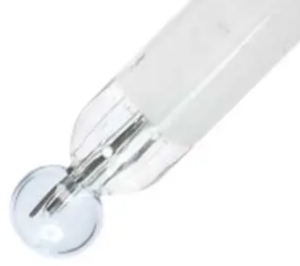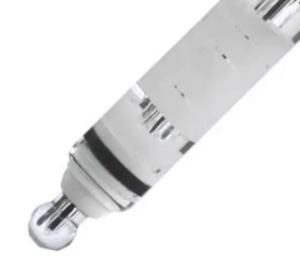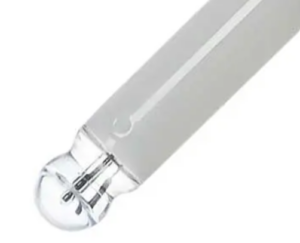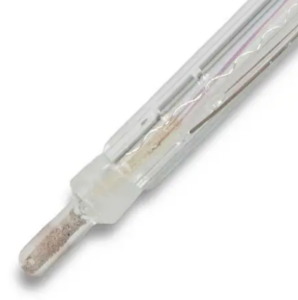The junction, or sensor diaphragm, is one of the most important aspects of a pH sensor’s construction. The sensor junctions act as the link between the reference system and the process fluid. The junction serves two primary roles; it allows ion activity and electrical coupling to pass through to the reference system and acts as a barrier between the reference electrolyte and the process fluid.
pH sensor diaphragms come in different makeups and materials. Therefore, choosing the right junction style for each application is essential for your sensor performance. Even the best pH sensor will perform poorly in an application it is not well-suited to. Below, we will examine four of the most common junction styles and provide insight into the unique properties of each that make them more applicable to certain applications.
Ceramic Junctions
 Ceramic junctions can be utilized in a wide range of applications. The porous nature of the ceramic material creates a pathway for ion exchange. It contains numerous microscopic pores that provide a pathway for the migration of ions. The size and distribution of these pores can vary depending on the sensor manufacturer, affecting the sensor’s response time and resistance to clogging. As a result, pH sensors with ceramic junctions are best in applications with lower percentages of suspended solids. In applications where there is low ionic activity, it is common to incorporate multiple ceramic junctions.
Ceramic junctions can be utilized in a wide range of applications. The porous nature of the ceramic material creates a pathway for ion exchange. It contains numerous microscopic pores that provide a pathway for the migration of ions. The size and distribution of these pores can vary depending on the sensor manufacturer, affecting the sensor’s response time and resistance to clogging. As a result, pH sensors with ceramic junctions are best in applications with lower percentages of suspended solids. In applications where there is low ionic activity, it is common to incorporate multiple ceramic junctions.
To ensure proper functioning, it is important to keep the ceramic junction clean and free from any blockages. Regular maintenance, such as cleaning and calibration, is necessary to maintain accurate pH measurements.
 Open Junctions
Open Junctions
Open-style junctions differ from most junctions in that there is direct contact between the reference system and the process fluid. A polymer reference electrolyte is used in open junction pH sensors to link the reference electrode to the process and minimize fouling.
Additionally, open junction sensors work well in process fluids where there are higher percentages of suspended solids. Regular cleaning and maintenance are necessary to maintain the accuracy and reliability of pH measurements with open junction sensors.
Annular Junctions
 Annular pH sensor junctions consist of two concentric tubes or rings made of different materials, typically PTFE. PTFE has low ionic conductivity, meaning it does not contribute significant electrical current or interfere with the pH measurement process. This property allows for a stable and well-isolated reference potential at the reference electrode, enhancing the accuracy of the pH measurement. Furthermore, annular or ring junctions have a large surface area that is resistant to buildup from oils and suspended solids.
Annular pH sensor junctions consist of two concentric tubes or rings made of different materials, typically PTFE. PTFE has low ionic conductivity, meaning it does not contribute significant electrical current or interfere with the pH measurement process. This property allows for a stable and well-isolated reference potential at the reference electrode, enhancing the accuracy of the pH measurement. Furthermore, annular or ring junctions have a large surface area that is resistant to buildup from oils and suspended solids.
The outer ring acts as a protective barrier and is chemically resistant, while the inner ring serves as the actual reference junction. The inner ring is typically a porous material, that allows ion exchange and electrolyte flow. Furthermore, the outer ring of the annular junction acts as a protective barrier, shielding the inner reference junction from direct contact with the measured solution. This prevents contamination or fouling of the reference electrode, contributing to the longevity and accuracy of the pH sensor. The annular design provides better control of the electrolyte flow. This is particularly beneficial when measuring pH in challenging environments where there are fluctuations in temperature, pressure, or flow rate.
 Ground Glass (Sleeves) Junctions
Ground Glass (Sleeves) Junctions
Ground glass sleeve pH sensor junctions are compatible with a wide range of applications. The glass material is resistant to chemical reactions and can withstand various pH ranges, making it suitable for a variety of water and wastewater applications. Additionally, this junction type is also resistant to algae buildup.
It is important to note that ground glass sleeve pH junctions may require occasional wetting or conditioning before use to ensure proper functioning. This involves soaking the junction in an appropriate reference electrolyte solution to facilitate ion exchange and establish a stable reference potential.
Summary
Understanding the different pH sensor junction styles is crucial for selecting the appropriate sensor for your specific application. The choice of junction style impacts factors such as response time, resistance to clogging, chemical compatibility, and maintenance requirements. Ultimately, the pH sensor junction style selection should be based on your application’s specific requirements and conditions. Consider factors such as the nature of the application, desired response time, and the need for maintenance. By understanding the characteristics of each junction style, you can make an informed decision and ensure accurate and reliable pH measurements in your processes.

 Open Junctions
Open Junctions Ground Glass (Sleeves) Junctions
Ground Glass (Sleeves) Junctions
